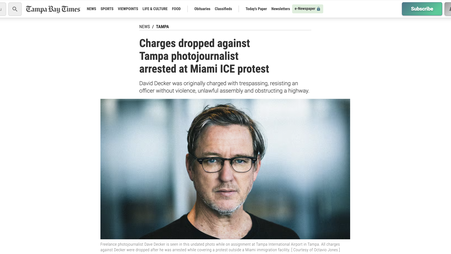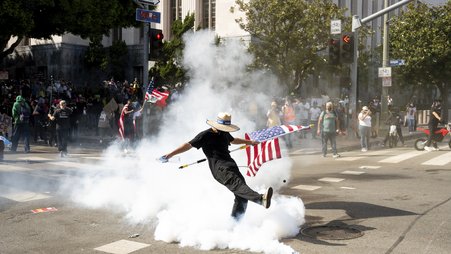Freedom of the Press Foundation (FPF) Deputy Director of Advocacy Caitlin Vogus speaks to National Press Photographers Association General Counsel Mickey Osterreicher and law professor Susan Seager about the dangers facing journalists covering protests and what can be done.
Editor’s note: “From Bylines to Behind Bars” was recorded before news broke that a Stanford Daily student reporter was arrested while covering the occupation of a Stanford University campus building by pro-Palestinian protesters.
Alarming new data from the U.S. Press Freedom Tracker shows that less than halfway into 2024, the number of journalists arrested or detained so far this year is already more than the last two years combined.
Most of those arrests and detentions have happened at protests, specifically the national protests around the Israel-Gaza war. The Tracker has also documented numerous instances of assaults on journalists and reports of equipment damage.
On June 5, we spoke to two experts, Mickey Osterreicher of the National Press Photographers Association and law professor Susan E. Seager, about why protests remain one of the most dangerous places for journalists, and what reporters and everyone can do about it.
Listen to the full conversation on X.
Police are arresting journalists who are doing their jobs
Seager and Osterreicher both recounted incidents of police arresting or detaining reporters covering protests, despite the First Amendment and laws intended to protect their right to report on demonstrations.
Police in California, where Seager is based, are “generally ignoring the law by arresting reporters who are just doing their jobs,” she said.
Osterreicher described the situation in New York as a “mixed bag.” After police beat, arrested, and harassed numerous journalists in New York City while they were covering racial justice protests over the police killing of George Floyd, the NPPA and others filed suit and won a settlement that’s meant to rein in the New York City Police Department’s abuse of journalists.
But that hasn’t stopped police from violating reporters’ rights during more recent protests, including by using “catch and release” tactics where officers take journalists into custody for several hours or longer, preventing them from reporting but without ever charging them.
Protection or peril from press credentials
Freelance journalists and visual journalists are especially vulnerable to police, Seager and Osterreicher said, and both emphasized the importance of having a press pass that reporters can use during interactions with law enforcement.
Credentials issued by a news outlet or a journalism organization like NPPA, or even created by reporters themselves can help journalists identify themselves as press to police and assert their rights.
Yet at the same time, clearly identifying as press can expose reporters to violence from protest participants who may not want to be recorded or photographed. “It’s a very fine line for visual journalists to walk,” Osterreicher said. He recommended that reporters maintain situational awareness all the time and keep recording, even if they are attacked.
Search and seizure of journalists’ devices
Osterreicher and Seager also discussed the seizure of journalists' equipment by police and the risk that police will try to obtain a search warrant to search devices, even if the law prohibits it.
“If they charged you with conspiracy or the arrest papers say you’ve been arrested on suspicion of conspiracy,” Seager warned journalists, “then that's a signal that they're probably going to get a search warrant to search your phone.”
Seager pointed to the case of journalist Pablo Unzueta, who was arrested in 2020 while covering a protest and whose device was seized, along with those of several protesters facing conspiracy charges. Seager’s Press Freedom Project eventually won a settlement on Unzueta’s behalf, in part based on the illegal searches of his devices.
More recently, University of California, Los Angeles, police arrested journalist Sean Beckner-Carmitchel and prominent police critic William Gude while they were documenting the detentions of protesters in May 2024. Police charged Beckner-Carmitchel with conspiracy to commit burglary and seized his phone, and Seager believed they intended to obtain a search warrant to search it. Using the settlement in Unzueta’s case and other legal precedent, Seager was able to convince police to return the device.
Preventing future First Amendment violations
Finally, Osterreicher and Seager talked about what can be done to prevent additional violations of journalists’ rights to cover protests.
Osterreicher pointed to a shocking lack of understanding on behalf of many police officers of journalists’ legal rights and the need for additional training. “The fact is that all law enforcement take an oath, they swear an oath to uphold the Constitution,” said Osterreicher. “It's kind of hard to do that when you don't understand what it is that's in there.”
Osterreicher also underscored the importance of communication between journalists and police before protests, advocating for discussions to establish rules of engagement. “You're not going to be able to have a good conversation in the middle of a protest,” Osterreicher said. Instead, conversations between the media and the police must happen in advance.
Seager suggested engaging with local governmental bodies to advocate for public hearings on how police departments treat the press. “The local city councils and board of supervisors have been too passive,” she said. Hearings could be an opportunity to “make the police come talk about what they're doing and have reporters testify about what's happened to them.”
Listen to the full conversation with Osterreicher and Seager here.





